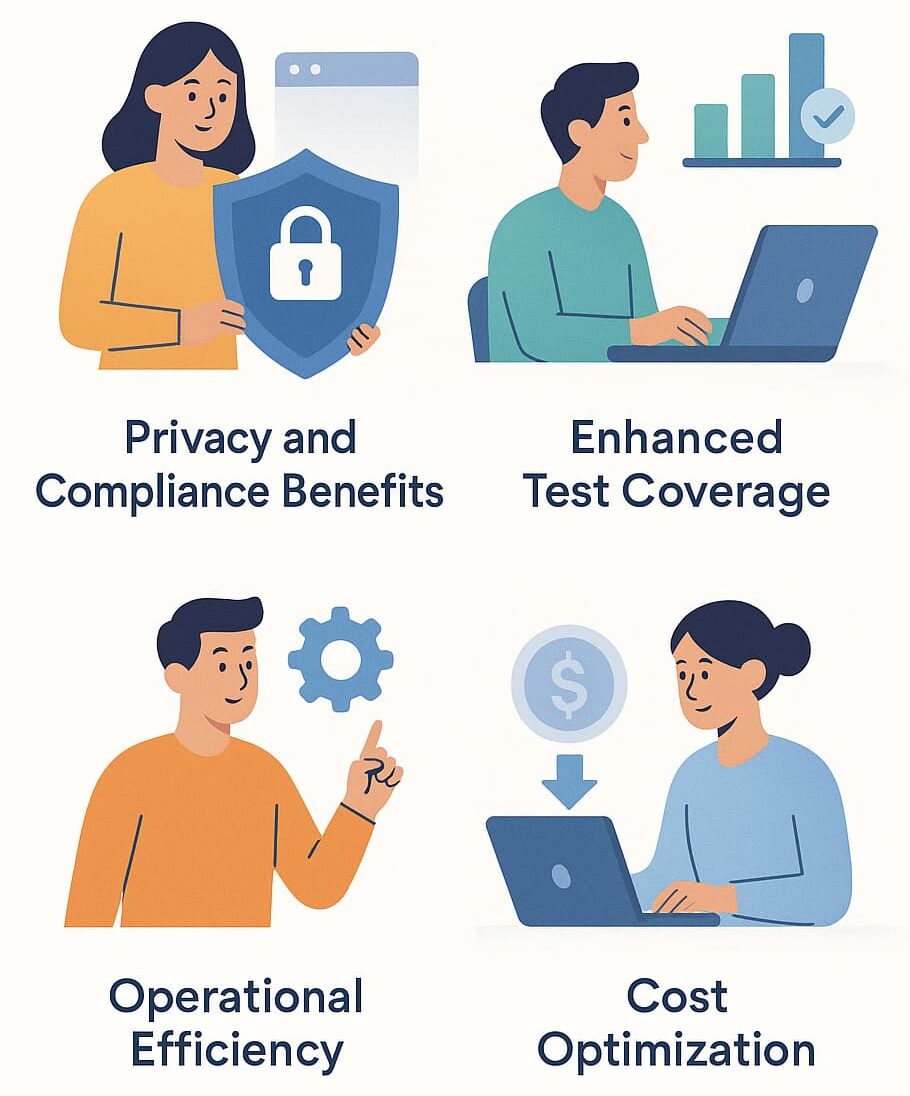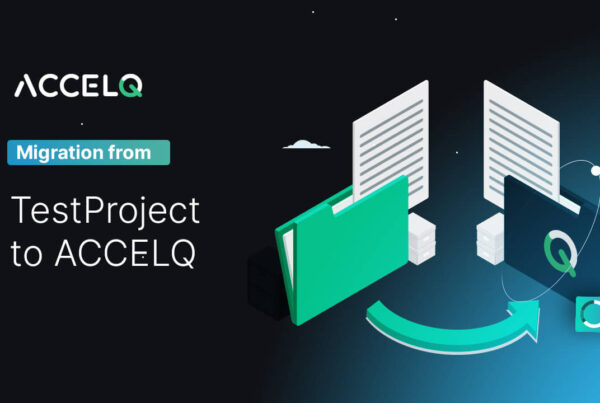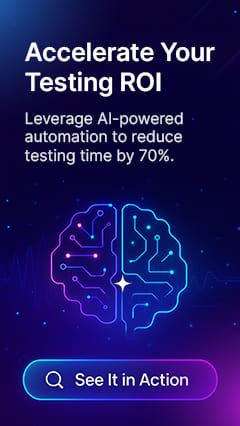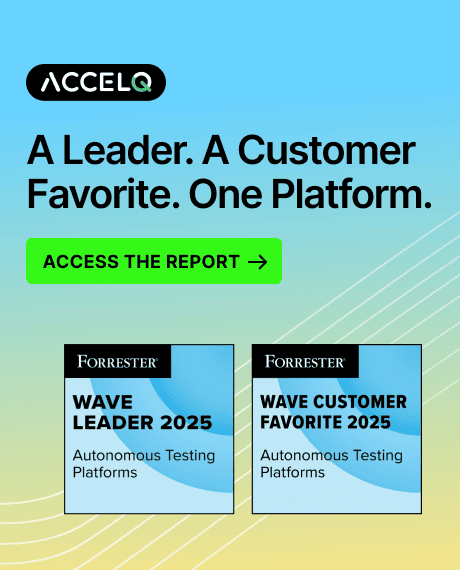Synthetic Data Generation in Automation Testing: A Complete Guide

Testing with production data creates massive risk. Every query exposes customer information, violates privacy regulations, and triggers compliance nightmares. But here’s the catch: using bad test data means critical bugs stay hidden until production crashes.
The penalties keep climbing. GDPR fines now average €20 million per incident. Healthcare providers face HIPAA penalties that can bankrupt smaller organizations overnight. Financial services must navigate overlapping rules from every country in which they operate, each interpreting data privacy differently. One leaked test dataset changes everything. Legal teams take control, development freezes, and innovation grinds to a halt.
Gartner predicts that 75% of businesses will utilize generative AI for synthetic customer data by 2026. We’re watching organizations rethink their entire approach to test data. Synthetic data generation in automation testing transforms this landscape by creating artificial data that mirrors real-world patterns without containing actual sensitive information.
- What is Synthetic Data Generation?
- Key Differences: Synthetic vs Mock Data
- How is Synthetic Data Generated?
- Advantages of Synthetic Data Generation in Automation Testing
- How to Create Synthetic Data: Implementation Steps?
- ACCELQ's Approach to Synthetic Data
- Best Practices for Synthetic Data Generation
- Real-World Impact
- Future of Synthetic Data in Testing
- Getting Started with Synthetic Data
What is Synthetic Data Generation?
Synthetic data behaves like production data but contains no personal information. Mock data uses random junk. Synthetic data generation using generative AI keeps statistical patterns, relationships, and business rules intact. Age correlates with income. Addresses match shipping zones. Purchase histories make sense.
Key Differences: Synthetic vs Mock Data
| Aspect | Mock Data | Synthetic Data |
|---|---|---|
| Pattern Preservation | Random values | Maintains statistical distributions |
| Relationships | Independent fields | Preserves data correlations |
| Business Logic | Basic validation | Complex rule compliance |
| Realism | Obviously fake | Production-like quality |
| Scale | Limited variety | Unlimited variations |
How is Synthetic Data Generated?
Modern synthetic data generation combines statistics, AI, and business rules to create test data indistinguishable from production. Three techniques dominate:
1. Statistical Distribution Methods
- Parameter Estimation: Maps original data distributions
- Kernel Density: Handles non-standard patterns
- Correlation Preservation: Keeps field relationships intact
2. Generative AI Approaches
Synthetic data generation took off when AI got smart enough to matter:
- Generative Adversarial Networks (GANs): They play the ultimate con game. A generator creates fake data, while a discriminator attempts to identify the fakes. The process repeats until the synthetic data becomes indistinguishable from real data. Financial institutions utilize this method to establish fraud detection patterns without compromising customer information.
- Language models have become data factories: feed them ten real customer records, and they’ll generate ten thousand synthetic ones.
- Variational Autoencoders (VAEs) work like data distilleries: They compress your data down to its mathematical DNA, then use that blueprint to spawn endless variations. Each synthetic record matches your data’s statistical profile while containing zero real information.
3. Rule-Based Generation
- Business logic implementation
- Constraint-based creation
- Template-driven generation
Advantages of Synthetic Data Generation in Automation Testing
Switch to synthetic data generation in automation testing and watch testing transform. Four areas see immediate impact:

Privacy and Compliance Benefits
- Zero PII exposure: Test freely without privacy concerns
- Built-in compliance: GDPR, HIPAA compliant by design
- Global collaboration: Share data across borders legally
- Simple audits: Prove compliance with synthetic usage
Enhanced Test Coverage
- Create unlimited edge cases missing from production
- Balance datasets for minority scenarios
- Test rare failures safely
- Fill gaps when real data doesn’t exist
Operational Efficiency
| Benefit | Traditional Approach | Synthetic Data |
|---|---|---|
| Data Provisioning | Days/Weeks | Minutes |
| Volume Scaling | Limited by production | Unlimited |
| Environment Refresh | Complex coordination | On-demand |
| Test Independence | Shared data conflicts | Isolated datasets |
Cost Optimization
- Eliminate data masking tools
- Cut storage for test copies
- Reduce manual creation effort
- Minimize audit overhead
How to Create Synthetic Data: Implementation Steps?
Successful synthetic data creation transforms raw production patterns into unlimited test data within weeks:
Phase 1: Assessment and Planning
- Analyze data structures: Document schemas and relationships
- Identify sensitive fields: Find all PII and regulated data
- Define requirements: Volume, complexity, quality metrics
- Select tools: Evaluate platforms like ACCELQ’s test automation
Phase 2: Configuration and Generation
- Connect to source systems: Auto-discover schemas
- Configure generation rules: Set business constraints
- Train AI models: Use representative samples
- Generate and validate: Create data with quality checks
Phase 3: Integration
- Embed in CI/CD pipelines
- Schedule automated refreshes
- Enable real-time generation
- Implement version control
ACCELQ’s Approach to Synthetic Data
ACCELQ builds synthetic data AI into the testing platform. No separate tools. No complex integration. Just data when you need it:
Visual Data Generation
- No-code canvas: Design data behavior visually
- Business-friendly: Create “customers” not “database records”
- Automated relationships: Maintain referential integrity
- Risk-based generation: Cover all test scenarios
Unified Platform Benefits
- Works across web, mobile, and API testing
- Central data management
- Real-time generation
- Handles enterprise complexity
AI-Powered Intelligence
ACCELQ’s AI doesn’t just generate random data. It learns your business:
- Smart generation: Creates data based on actual risk factors in your application
- Complete coverage: Automatically produces every permutation that matters
- Business awareness: Respects your rules without being told twice
- Adaptive learning: Improves with self-healing capabilities as your application evolves
Unlike standalone tools that require complex integration and specialized expertise, ACCELQ embeds generation directly into your testing workflow. Generate test data during test design. Refresh it during execution. Update it when requirements change. All without leaving the platform.
📈 Accelerate Your Testing ROI
Leverage AI-powered automation to reduce testing time by 70%.
Best Practices for Synthetic Data Generation
Smart implementation separates successful synthetic data adoption from expensive failures:
Data Quality Management
- Regular validation: Automated daily quality checks
- Continuous monitoring: Track generation metrics
- Feedback loops: Improve based on test results
- Version control: Track configuration changes
Privacy and Security
- Implement differential privacy techniques
- Regular privacy audits
- Role-based access controls
- Secure generation infrastructure
Performance Optimization
- Algorithm tuning for speed
- Intelligent caching strategies
- Parallel generation for scale
- Resource usage monitoring
Real-World Impact
ACCELQ clients across industries see transformative results: The world’s largest airline achieved 73% cost savings across 1.95 million test executions. A leading telecom company reduced testing time by 70% while achieving 3x faster testing. A top financial services firm cut costs by 72%, reducing expenses to one-third.
The formula is simple. Get test data instantly, and testing takes off. Remove privacy concerns, and innovation catapults.
Read our customer success stories to see how enterprises transform testing with synthetic data.
Future of Synthetic Data in Testing
$2.1 billion by 2028 with 45.7% annual growth: These projected numbers tell a story.
Privacy laws keep getting stricter everywhere. Every quarter brings new rules somewhere. Organizations using production data for testing face escalating legal exposure and reputational risk.
Modern apps create new complexities. Microservices involve hundreds of interconnected systems. Manual test data creation cannot scale to address these challenges.
The game changed when AI finally cracked the code on realistic synthetic data. Today’s synthetic data fools statistical tests, respects business logic, and catches the same nasty bugs production data would find.
Getting Started with Synthetic Data
Here’s how you make the switch to synthetic data in four simple steps:
- Assess your situation: Track how long teams wait for test data. Add up yearly data masking costs. Count privacy incidents. Real numbers reveal real problems.
- Pick the right pilot: Start with customer portals or similar systems. Clear boundaries make success measurable. Save enterprise systems for phase two.
- Measure what matters: Time to provision environments. Defects caught before production. Audit findings. Complex data builds confidence.
- Build for growth: Early wins create demand. Other teams will want synthetic data too. Plan infrastructure accordingly.
Initial synthetic data might not match production perfectly. That’s fine. Instant availability beats waiting weeks for masked data. Zero privacy risk beats potential breaches. Starting today beats starting next month.
Test automation without reliable data is a broken promise. With ACCELQ, you get both. Book your demo now and see how synthetic data accelerates your testing from day one.
Balbodh Jha
Associate Director Product Engineering
Balbodh is a passionate enthusiast of Test Automation, constantly seeking opportunities to tackle real-world challenges in this field. He possesses an insatiable curiosity for engaging in discussions on testing-related topics and crafting solutions to address them. He has a wealth of experience in establishing Test Centers of Excellence (TCoE) for a diverse range of clients he has collaborated with.
You Might Also Like:
 Smart Visual Testing: How to Catch What the Eyes Miss?
Smart Visual Testing: How to Catch What the Eyes Miss?
Smart Visual Testing: How to Catch What the Eyes Miss?
 Migration From TestProject to ACCELQ
Migration From TestProject to ACCELQ
Migration From TestProject to ACCELQ
 Can You Achieve 100% Test Automation (And Do You Really Need It)?
Can You Achieve 100% Test Automation (And Do You Really Need It)?

































